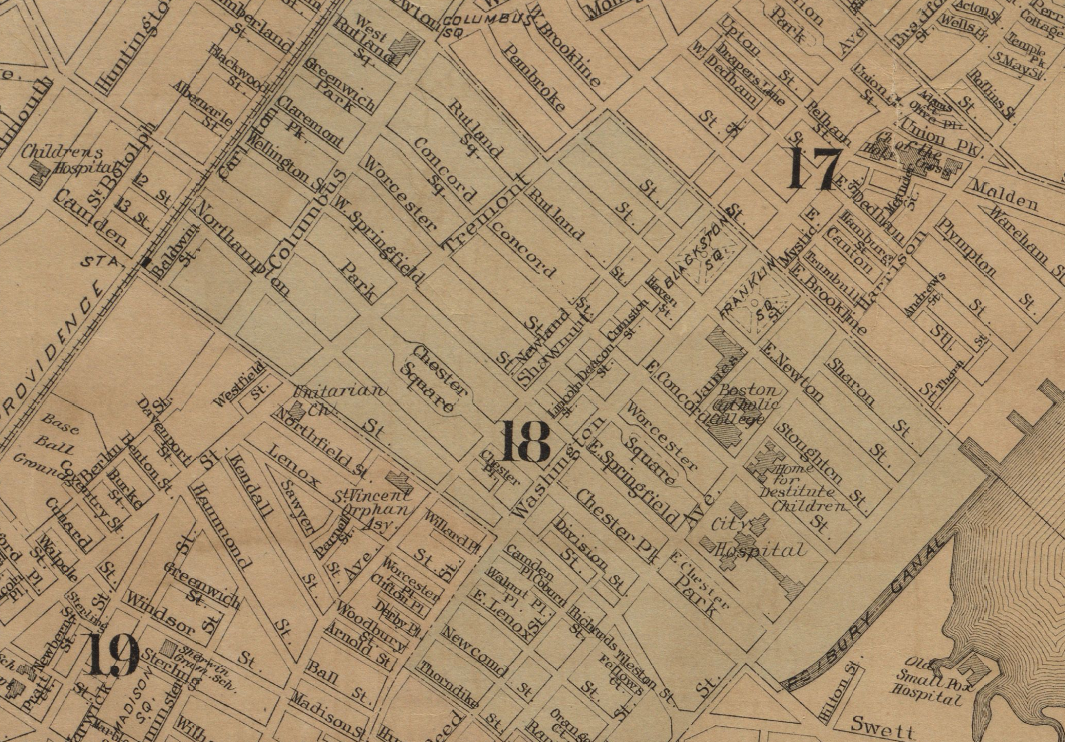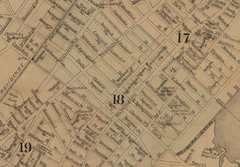
Cathedral of the Holy Cross Boston: Visiting Hours, Tickets, and Historical Sites Guide
Date: 15/06/2025
Introduction
Nestled in Boston’s vibrant South End, the Cathedral of the Holy Cross stands as New England’s largest Roman Catholic cathedral and a magnificent symbol of faith, resilience, and architectural excellence. As the mother church of the Archdiocese of Boston, it reflects the city’s rich immigrant heritage and serves as a cultural, spiritual, and community beacon. This comprehensive guide offers detailed insights into the cathedral’s history, visiting hours, admission policies, architectural marvels, and practical tips for exploring the surrounding historic neighborhoods. For the latest updates on visiting hours, guided tours, and events, refer to the cathedral’s official website. Additional resources include Elkus Manfredi Architects, Lonely Planet, and gpsmycity.
Table of Contents
- History of the Cathedral of the Holy Cross
- Visitor Information
- Community Role & Social Impact
- Renovations & Preservation
- Architectural Highlights
- Liturgical and Cultural Significance
- Frequently Asked Questions (FAQ)
- Conclusion & Further Resources
- Sources
History of the Cathedral of the Holy Cross
Early Catholic Presence and the First Cathedral
Boston’s Catholic roots began in the early 19th century with the construction of the original Church of the Holy Cross on Franklin Street (1800–1803), designed by Charles Bulfinch. This church became Boston’s first Catholic cathedral in 1808, serving a small but growing Catholic minority in a predominantly Protestant city. As immigration—especially from Ireland—increased, the need for a larger cathedral became evident. The original building was demolished in 1862 to make way for a grander structure (gpsmycity).
Planning and Construction
In 1859, Bishop John Fitzpatrick acquired marshland in the South End to build a new cathedral, though the Civil War delayed progress. Bishop John Williams revived the project post-war, commissioning Patrick C. Keely, a prolific Irish-American architect, to design the Gothic Revival edifice. Construction began in 1866, funded through broad-based parishioner donations. The cathedral was dedicated on December 8, 1875, marking Boston’s elevation to an archdiocese (Elkus Manfredi).
Architectural Significance
The Cathedral of the Holy Cross is a prominent example of American Gothic Revival architecture. Built with native Roxbury puddingstone and Quincy granite, it features a cruciform plan, 364 feet in length, and a nave that rises 120 feet. The cathedral boasts New England’s largest collection of stained glass windows and houses the historic Hook & Hastings pipe organ. Its interior showcases cast-iron pillars, oak carvings, and artistic details symbolizing Boston’s Catholic heritage (Lonely Planet).
Visitor Information
Hours & Admission
-
Visiting Hours:
- Monday–Saturday: 9:00 AM – 5:00 PM
- Sunday: 7:00 AM – 7:00 PM
(Hours may vary for special services and holidays. Always confirm on the official website.)
-
Admission:
Admission is free; donations are welcomed to support ongoing maintenance and community outreach programs.
Guided Tours & Accessibility
-
Guided Tours:
Available by appointment, providing deeper insights into the cathedral’s history, art, and architecture. Self-guided visits are welcome during open hours. -
Accessibility:
The cathedral is fully accessible, with ramps, elevators, accessible restrooms, hearing assistance devices, and large-print worship aids upon request.
Getting There & Nearby Attractions
- Location: 1400 Washington Street, Boston, MA, in the South End.
- Public Transit:
- MBTA Orange Line (Back Bay Station) and Massachusetts Avenue Station are nearby.
- Several bus routes serve the area (MBTA Trip Planner).
- Parking: Limited street parking; public transit or rideshare is recommended.
Nearby Attractions:
- Boston Public Library
- Copley Square
- Freedom Trail
- Boston Public Garden
- SoWa Art + Design District
- Back Bay’s historic brownstones and restaurants
Visitor Tips
- Photography is allowed (no flash/tripods during services).
- Dress modestly, especially during liturgies.
- Silence cell phones; food and drink are not permitted inside.
- Check event schedules (Boston Catholic Events Calendar) for special Masses and concerts.
Community Role & Social Impact
The Cathedral of the Holy Cross is the spiritual heart of Boston’s Catholic community and the seat of the Archbishop. It hosts major liturgical celebrations, including ordinations, archdiocesan events, and commemorations such as the annual Chrism Mass and citywide memorials. Its multicultural ministry offers Masses in English, Spanish, and other languages, supporting Boston’s diverse Catholic population (bostoncathedral.com).
Beyond worship, the cathedral is a center for social outreach—operating food pantries, homeless support, and immigrant services in partnership with local organizations. Recent years have seen it serve as a venue for interfaith events and civic gatherings, emphasizing unity and compassion (gpsmycity).
Renovations & Preservation
Between 2018 and 2019, the cathedral underwent a $26 million restoration led by Elkus Manfredi Architects and Suffolk Construction. The project restored woodwork, replaced flooring, updated systems, and improved accessibility while preserving original architectural details. The restoration has received multiple awards for excellence in design and historic preservation (Elkus Manfredi).
Architectural Highlights
- Stained Glass:
The cathedral’s stained-glass windows—many imported from Munich—depict saints, biblical scenes, and Catholic symbols, filling the nave with vibrant color. - Rose Window:
Positioned above the main entrance, the rose window features King David and intricate tracery, serving as a visual focal point (Lonely Planet). - Pipe Organ:
The historic Hook & Hastings organ from 1875 is renowned for its sound and craftsmanship, often featured in liturgies and concerts. - Symbolic Details:
Bricks from the 1834 Ursuline Convent riots are incorporated above the main entrance, a testament to the community’s resilience (Kiddle).
Liturgical and Cultural Significance
As the Archdiocese’s mother church, the cathedral is central to Catholic worship in Boston, offering daily and Sunday Masses in multiple languages (bostoncathedral.com/mass-times). It hosts major events, such as the Jubilee Year 2025 “Pilgrims of Hope,” and is a key pilgrimage destination. The cathedral’s rich tradition of sacred music, highlighted by its choir and historic organ, adds to its liturgical vibrancy (Cathedral Mass Schedule).
Frequently Asked Questions (FAQ)
Q: What are the cathedral’s visiting hours?
A: Generally, Monday–Saturday 9:00 AM–5:00 PM, Sunday 7:00 AM–7:00 PM. Confirm on the official website.
Q: Is there an admission fee?
A: No, admission is free. Donations are appreciated.
Q: Are guided tours available?
A: Yes, by appointment. Contact the cathedral office.
Q: Is the cathedral accessible?
A: Yes, with full wheelchair access, hearing devices, and accessible restrooms.
Q: Can I take photographs inside?
A: Yes, but avoid flash and tripods during services.
Q: Are Masses offered in languages other than English?
A: Yes, regular Spanish Masses and occasionally other languages.
Conclusion & Further Resources
The Cathedral of the Holy Cross stands as a testament to Boston’s rich heritage, spiritual vitality, and architectural grandeur. Whether you visit for prayer, history, art, or community connection, the cathedral offers a welcoming and inspiring experience. Keep up with events and visitor information on the official website, and consider using the Audiala app for enhanced guided tours and content.
Sources
- Boston Cathedral official website
- Elkus Manfredi Architects
- gpsmycity
- Holy Cross Boston visitor guide
- Lonely Planet: Cathedral of the Holy Cross Boston
- Boston Catholic Events Calendar
- Kiddle: Cathedral of the Holy Cross
- Aleteia: Historic Catholic Churches in Boston
- Boston Globe: Cathedral restoration
- Boston Musical Intelligencer
- MBTA Trip Planner

































































































































